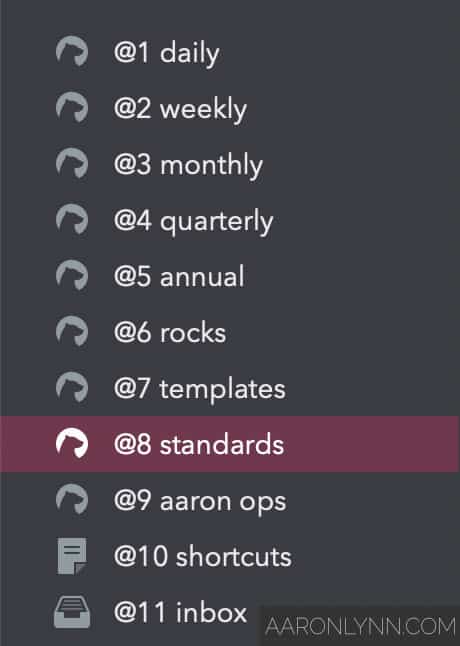
Any time you sincerely want to make a change, the first thing you must do is to raise your standards.
Tony Robbins
Standards are the system of how you live your life.
They exist as a singular document that you can refer to and check in with daily, to hold yourself accountable.
Here’s how they work.
What Are Standards?
Standards are our personal metrics and measurements for how we act, behave and live across the different areas of our lives.
They are the list of things that we consider the bare minimum acceptable for ourselves.
They may look like this:
* I will only spend time on things I enjoy or with people that I actually like. * Have no time to live or spend above my means. * I wake up at 5am, every day.
Organisationally, they sit as a document between our personal ops and our journal entries:
Your standards can also be thought of as your personal code — the rules that you set for yourself and follow in your life.
They are also your ongoing processes — habits, behaviours and things you want to be consistently doing.
Why Bother With Standards at All?
Between having journal entries, goals, core values and a purpose in life… why do we even need standards at all?
As Tony Robbins states, standards provide the minimum benchmark for your life, and can be used to fuel change in your life.
They act as a form of intrinsic motivation to drive you to not compromise the promises you have made to yourself.
When you have your own set of standards, you start to care less about what others think of you because you already know that how you live is “good enough” according to yourself.
Creating Your First Set of Standards
Let’s get practical.
To create your first set of standards, you need to open a new document in your journal, and then structure it like this:
General * Standard 1. * Standard 2. * Standard 3. Wealth * Standard 1. * Standard 2. * Standard 3. Health * Standard 1. * Standard 2. * Standard 3. Relationship * Standard 1. * Standard 2. * Standard 3. Learning/Growth * Standard 1. * Standard 2. * Standard 3. Social * Standard 1. * Standard 2. * Standard 3. Play * Standard 1. * Standard 2. * Standard 3.
“General” describes your overall life standards, and the remainder of the areas are the standards across each area of life.
3-5 standards per area is more than enough — don’t go too crazy with this.
What does a standard actually look like?
You can think of standards as the bare minimum acceptable for yourself in each area. You can also think of them as what you aspire to be, but aren’t quite there yet.
For example, a health standard may be:
I will wake up every day at 5am.
This doesn’t mean that you will wake up every single day at 5am sharp, but it does mean that most of the time you will.
Where do my standards come from?
Your standards are derived from your personal ops documents — your purpose/mission, your core values, your reasons why, and your list of virtues and vices.
Remember that your standards are deeply personal to you. There is no need to share them with anyone else, and there is no need for you to conform to anyone else’s standards.
Can you show me some more example standards?
Sure.
Here’s some example standards across each area:
General * Live my mission and purpose daily. * Be busy from the time I wake up until the time I go to sleep. Wealth * Live below my means. * Have 6 months of expenses saved. Health * Wake up at 5am every day. * Walk for 20 minutes every day. * Drink at least 2L of water every day. Relationship * Spend time, no matter how brief, with my SO every day. * Have 1 date night a week. Learning/Growth * Always be reading. Reading should be like breathing to me. Social * Only spend time with people I like. * Zero drama. Play * Practice high quality play, instead of mindless distractions. * Cook 1 new recipe every week.
These are only example standards.
Standards are highly individual and what matters more is that the standards are right for you, your mission in life and your goals in life.
Using Your Standards Daily
Once you have a document of your own standards, you can use your standards daily.
As such:
- Read them in the morning.
- Read them in the evening.
- Reference them whenever you are setting goals or reviewing goals you’ve accomplished.
- Actually live them. By reading them daily, you know if you are meeting your own standards or not, and can adjust immediately.
Reviewing Your Standards
You should review your standards on a quarterly basis. This is just reading over them with some thought and checking that they’re still valid.
You should write a new standards document every year during your annual review.
Your standards for the new year may mostly be the same as the previous year… but hopefully you are raising some of your standards on an annual basis to become the person you want to be.
What To Do Next
Write out your first standards document.
And then apply it — take your standards, and use them to set your goals across cascading timeframes. And then live them — that’s what our personal standards are for!
Photo by Hans Reniers.
